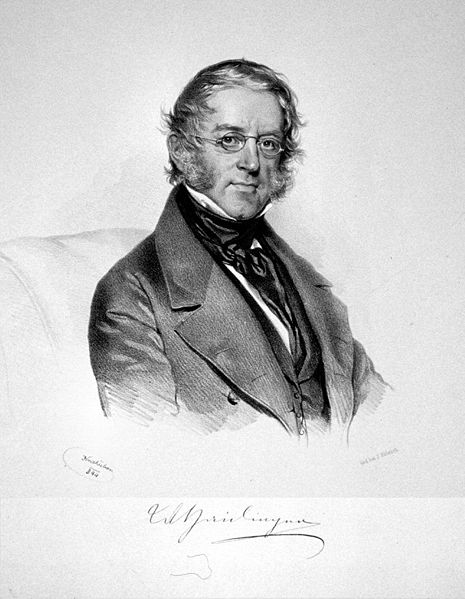<Back to Index>
- Geologist Wilhelm Karl Ritter von Haidinger, 1795
- Poet Esteban Manuel de Villegas, 1589
- Prince of Orange René of Châlon, 1519
PAGE SPONSOR

Wilhelm Karl Ritter von Haidinger (or Wilhelm von Haidinger) (5 February 1795 – 19 March 1871) was an Austrian mineralogist, geologist and physicist.
He was born at Vienna; his father, Karl Haidinger, contributed largely to the development of mineralogical science in the latter half of the 18th century. Having studied at the normal school of St Anne, and attended classes at the university, Wilhelm, at the age of seventeen, joined Professor Friedrich Mohs at Graz, and five years later accompanied the professor to Freiberg, Saxony, on the transfer of his labours to the mining academy of that town.
In 1822 Haidinger visited France and England with Count Breunner, and, journeying northward, took up his abode in Edinburgh. He translated into English, with additions of his own, Mohs's Grundriß der Mineralogie, published at Edinburgh in three volumes under the title Treatise on Mineralogy (1825). After a tour in northern Europe, including the Scandinavian mining districts, he undertook the scientific direction of the porcelain works at Elbogen, belonging to his brothers.
In 1840 he was appointed counsellor of mines (Bergrat) at Vienna in the place of Professor Mohs, a post which included the charge of the imperial cabinet of minerals. He devoted himself to the rearrangement and enrichment of the collections, and the museum became the finest in Europe. Shortly after 1843, Haidinger commenced a series of lectures on mineralogy, which was given to the world under the title Handbuch der bestimmenden Mineralogie (Vienna, 1845; tables, 1846).
After the establishment of the Imperial Geological Institute, he was chosen director in 1849; and this important position he occupied for seventeen years. He was elected a member of the imperial board of agriculture and mines, and a member of the Imperial Academy of Sciences of Vienna. He organized the society of the Freunde der Naturwissenschaften. In 1858, he was elected a foreign member of the Royal Swedish Academy of Sciences.
As a physicist Haidinger ranked highly, and he was one of the most active promoters of scientific progress in Austria. He was the first to observe the slight polarization dependence of the human eye, observed via the phenomenon now known as Haidinger's brush. Knighted in 1865, the following year he retired to his estate at Dornbach near Vienna, where he died on 19 March 1871.
In addition to the works already named, Haidinger published: Anfangsgründe der Mineralogie (Leipzig, 1829), Geognotische Übersichtskarte der österreichischen Monarchie (Vienna, 1847), Bemerkungen über die Anordnung der kleinsten Teilchen in Christallen (Vienna, 1853), Interferenzlinien am Glimmer (Vienna, 1855), Vergleichungen von Augit und Amphibo (Vienna, 1855).
He also edited the Naturwissenschaftliche Abhandlungen (Vienna, 1847); the Berichte über die Mitteilungen von Freunden der Naturwissenschaften in Wien (Vienna, 1847 – 1851); and the Jahrbuch of the Vienna KK Geologische Reichsanstalt (1850), etc.
Some of those papers will be found in the Transactions of the Royal Society of Edinburgh (vol. x.) and of the Wernerian Society (1822 – 1823), Edinburgh Phil. Journal, Brewster's Journal of Science, and Poggendorff's Annalen.